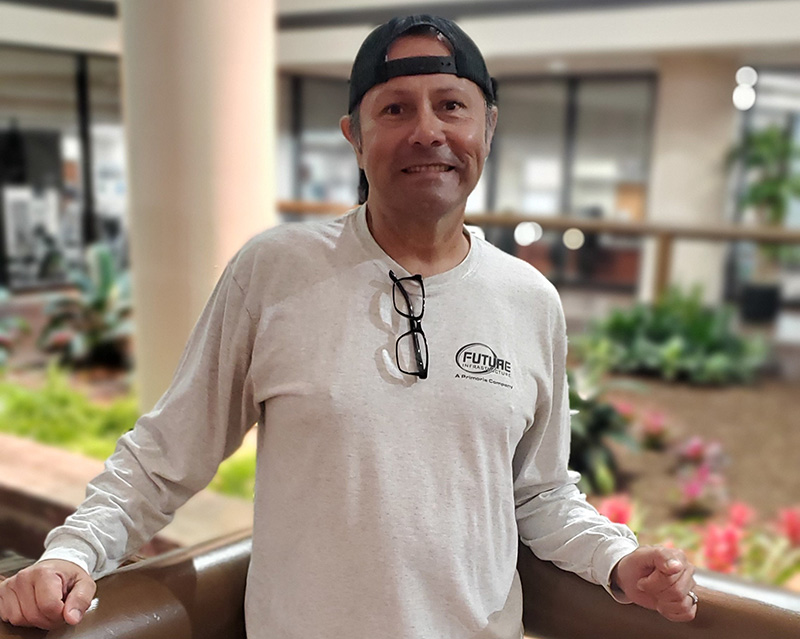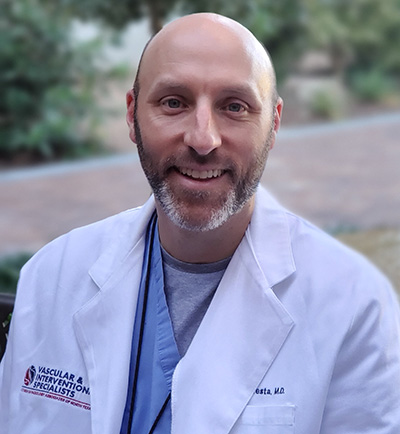FORT WORTH, Texas — Texas Brian Abalos had no fear of heights. As a lineman, Abalos never imagined a near-death experience would happen on the ground, as he arrived home from work. A ruptured brain aneurysm, which happens to nearly 30,000 people in the U.S. every year, would morph into multiple complications and the need for complex care offered at Texas Health Harris Methodist Hospital Fort Worth.

Brian Abalos
Abalos, 57, survived the ruptured brain aneurysm, which sometimes leads to brain damage, stroke, coma and even death. His successful recovery resulted from more than 30 days at Texas Health Fort Worth, receiving high-quality neurological care, involving several procedures, for not just the ruptured aneurysm but a stroke and deep vein thrombosis.
“Mr. Abalos survived what most patients die from,” said Matthew Fiesta, M.D., an interventional neuroradiologist on the Texas Health Fort Worth medical staff. “He faced so many life-threatening moments, which is why his story is so incredible.”
Paramedics arrived within minutes, taking Abalos to Texas Health Fort Worth, which is an Advanced Comprehensive Stroke Center and the first hospital in Tarrant County to earn The Joint Commission certification, one of the most prestigious in the U.S.
Receiving lifesaving neurosurgical care
Several tests, including brain imaging, located the ruptured artery on the back right side of Abalos’ head. The torn vessel wall caused blood to flow outside the artery and along the outer layers of brain tissue, which is called a hemorrhagic stroke.
Fiesta performed an emergency flow diversion embolization using the latest generation device approved by the FDA late last year. Texas Health Fort Worth is the first facility in North Texas to offer the advanced technology in February of this year; and in June, it launched commercially across the U.S.
The intricate technique involves insertion of a flexible microcatheter through an artery between the base of the thumb and wrist and guiding the flow diverter device to the ruptured brain vessel. The catheter is used to place a metallic mesh stent, which diverts blood away from the damaged blood vessel, strengthening the walls and preventing additional ruptures.
This was just the beginning of his journey.
Abalos’ bleeding ulcer was treated endoscopically by his care team. He then prepared for another procedure.
“We needed to reduce the risk of rebleeding,” said Robert J. Reeb Jr., M.D., an interventional radiologist on the Texas Health Fort Worth medical staff, who performed the procedure using a technique called embolization.
Making a small incision in Abalos’ upper thigh, a microcatheter was navigated through an artery up to his abdomen. To prevent future bleeding, Reeb said the main artery supplying the ulcer was closed by inserting tiny metallic coils inside the artery.
Additional exams revealed Abalos also had deep vein thrombosis, or blood clots inside a vein. Clots were found in Abalos’ legs and arms, and one had traveled to his lungs, which is known as a pulmonary embolus. The clot was restricting the flow of oxygen in his lungs.
Along with taking blood thinners, a small catheter was inserted to deploy a specialized filter that catches clots and prevents them from traveling to the heart and lungs.

“So much was happening,” Shelly Abalos, Brian’s wife, said. “I spent a lot of time on my knees, praying he’d get better.”
He also experienced a common side effect after aneurysm where a patient can suffer from an intracranial vasospasm, which is when blood vessels in the brain narrow, threaten oxygen supply and increase the risk of another stroke.
“Think of it like the muscles within the walls of the brain’s arteries are constantly cramping,” Fiesta said. “It’s as if your brain arteries are experiencing a Charley Horse, and that’s not good.”
Performing a balloon angioplasty, Fiesta used X-ray imaging to guide a balloon microcatheter to the spastic or “cramping” blood vessels. The balloon was inflated, enabling Fiesta to widen the arteries and restore oxygenated blood flow.
Finally, to prevent the rupture of another brain aneurysm, Fiesta performed a second flow diversion embolization, this time on the left back side of Abalos’ head.
Enjoying life after a critical medical emergency
After 32 days at Texas Health Fort Worth, Abalos returned home.
“Mr. Abalos’ successful recovery was the culmination of a cohesive, multidisciplinary care team, which included neurosurgery, interventional radiology and neuroradiology, gastroenterology and neurocritical care,” Fiesta said. “Having a comprehensive care team, combined with Texas Health Fort Worth having the latest flow diversion technology – everything added up to a positive outcome for Mr. Abalos.”
Abalos is back with his family and enjoying his 30-year career, 30 feet in the air, as a lineman.
“I could have had my stroke and passed out working on a utility pole, but that didn’t happen,” Abalos said. “I’m thankful and grateful, because I know that life can be gone in a second.”
To learn more about Texas Health Fort Worth providing advanced medical care across North Texas, click here.
Related News
About Texas Health Resources
Texas Health Resources is a faith-based, nonprofit health system that cares for more patients in North Texas than any other provider. With a service area that consists of 16 counties and more than 8 million people, the system is committed to providing quality, coordinated care through its Texas Health Physicians Group and 29 hospital locations under the banners of Texas Health Presbyterian, Texas Health Arlington Memorial, Texas Health Harris Methodist and Texas Health Huguley. Texas Health access points and services, ranging from acute-care hospitals and trauma centers to outpatient facilities and home health and preventive services, provide the full continuum of care for all stages of life. The system has more than 4,400 licensed hospital beds, 6,400 physicians with active staff privileges and nearly 29,000 employees. For more information about Texas Health, call 1-877-THR-WELL, or visit www.TexasHealth.org.
